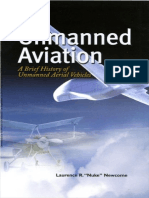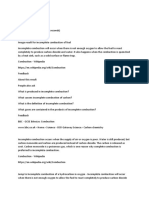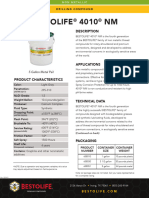0 ratings0% found this document useful (0 votes)
92 viewsAmbo University Hachalu Hundessa Campus School of Mechanical and Industrial Engineering Machine Element II, Assignment 1
Ambo University Hachalu Hundessa Campus School of Mechanical and Industrial Engineering Machine Element II, Assignment 1
Uploaded by
chalaThe document contains 9 problems related to machine elements and mechanical engineering. Problem 1 asks to determine the diameter of a solid shaft transmitting power. Problem 2 asks to determine the diameters of a solid and hollow shaft transmitting power. Problem 3 asks to determine the diameter of an axle between railway wagon wheels.
Copyright:
© All Rights Reserved
Available Formats
Download as PDF, TXT or read online from Scribd
Ambo University Hachalu Hundessa Campus School of Mechanical and Industrial Engineering Machine Element II, Assignment 1
Ambo University Hachalu Hundessa Campus School of Mechanical and Industrial Engineering Machine Element II, Assignment 1
Uploaded by
chala0 ratings0% found this document useful (0 votes)
92 views2 pagesThe document contains 9 problems related to machine elements and mechanical engineering. Problem 1 asks to determine the diameter of a solid shaft transmitting power. Problem 2 asks to determine the diameters of a solid and hollow shaft transmitting power. Problem 3 asks to determine the diameter of an axle between railway wagon wheels.
Original Title
Assigment
Copyright
© © All Rights Reserved
Available Formats
PDF, TXT or read online from Scribd
Share this document
Did you find this document useful?
Is this content inappropriate?
The document contains 9 problems related to machine elements and mechanical engineering. Problem 1 asks to determine the diameter of a solid shaft transmitting power. Problem 2 asks to determine the diameters of a solid and hollow shaft transmitting power. Problem 3 asks to determine the diameter of an axle between railway wagon wheels.
Copyright:
© All Rights Reserved
Available Formats
Download as PDF, TXT or read online from Scribd
Download as pdf or txt
0 ratings0% found this document useful (0 votes)
92 views2 pagesAmbo University Hachalu Hundessa Campus School of Mechanical and Industrial Engineering Machine Element II, Assignment 1
Ambo University Hachalu Hundessa Campus School of Mechanical and Industrial Engineering Machine Element II, Assignment 1
Uploaded by
chalaThe document contains 9 problems related to machine elements and mechanical engineering. Problem 1 asks to determine the diameter of a solid shaft transmitting power. Problem 2 asks to determine the diameters of a solid and hollow shaft transmitting power. Problem 3 asks to determine the diameter of an axle between railway wagon wheels.
Copyright:
© All Rights Reserved
Available Formats
Download as PDF, TXT or read online from Scribd
Download as pdf or txt
You are on page 1of 2
Ambo University
Hachalu Hundessa Campus
School of Mechanical and Industrial Engineering
Machine Element II, Assignment 1
1. A solid shaft is transmitting 1 MW at 240 r.p.m. Determine the diameter of the shaft if
the maximum torque transmitted exceeds the mean torque by 20%. Take the maximum
allowable shear stress as 60 MPa.
2. Find the diameter of a solid steel shaft to transmit 20 kW at 200 r.p.m. The ultimate
shear stress for the steel may be taken as 360 MPa and a factor of safety as 8. If a hollow
shaft is to be used in place of the solid shaft, find the inside and outside diameter when
the ratio of inside to outside diameters is 0.5
3. A pair of wheels of a railway wagon carries a load of 50 kN on each axle box, acting at a
distance of 100 mm outside the wheel base. The gauge of the rails is 1.4 m. Find the
diameter of the axle between the wheels, if the stress is not to exceed 100 MPa.
4. A solid circular shaft is subjected to a bending moment of 3000 N-m and a torque of 10
000 N-m. The shaft is made of 45 C 8 steel having ultimate tensile stress of 700 MPa and
a ultimate shear stress of 500 MPa. Assuming a factor of safety as 6, determine the
diameter of the shaft
5. An engine running at 150 r.p.m. drives a line shaft by means of a belt. The engine pulley
is 750 mm diameter and the pulley on the line shaft is 450 mm. A 900 mm diameter
pulley on the line shaft drives a 150 mm diameter pulley keyed to a dynamo shaft. Fine
the speed of dynamo shaft, when
1. there is no slip, and
2. there is a slip of 2% at each drive
Ambo University
Hachalu Hundessa Campus
School of Mechanical and Industrial Engineering
Machine Element II, Assignment 2
6. Design a belt drive to transmit 110 kW for a system consisting of two pulleys of
diameters 0.9 m and 1.2 m, centre distance of 3.6 m, a belt speed 20 m / s, coefficient of
friction 0.3, a slip of 1.2% at each pulley and 5% friction loss at each shaft, 20% over
load
7. A belt 100 mm wide and 10 mm thick is transmitting power at 1000 metres/min. The net
driving tension is 1.8 times the tension on the slack side. If the safe permissible stress on
the belt section in 1.6 MPa, calculate the maximum power, that can be transmitted at this
speed. Assume density of the leather as 1000 kg/m3.
Calculate the absolute maximum power that can be transmitted by this belt and the speed
at which this can be transmitted.
8. Two parallel shafts whose centre lines are 4.8 m apart, are connected by an open belt
drive. The diameter of the larger pulley is 1.5 m and that of smaller pulley 1 m. The
initial tension in the belt when stationary is 3 kN. The mass of the belt is 1.5 kg / m
length. The coefficient of friction between the belt and the pulley is 0.3. Taking
centrifugal tension into account, calculate the power transmitted, when the smaller pulley
rotates at 400 r.p.m.
9. In a horizontal belt drive for a centrifugal blower, the blower is belt driven at 600 r.p.m.
by a 15 kW, 1750 r.p.m. electric motor. The centre distance is twice the diameter of the
larger pulley. The density of the belt material = 1500 kg/m3; maximum allowable stress 4
MPa; μ1 = 0.5 (motor pulley); μ2 = 0.4 (blower pulley); peripheral velocity of the belt =
20 m/s. Determine the following:
1. Pulley diameters; 2. belt length; 3. cross-sectional area of the belt; 4. minimum initial
tension for operation without slip; and 5. resultant force in the plane of the blower when
operating with an initial tension 50 per cent greater than the minimum value
You might also like
- B48BB Tutorial Questions v3Document16 pagesB48BB Tutorial Questions v3aidaNo ratings yet
- PKG 825 Lab 1 Mechanical PropertiesDocument8 pagesPKG 825 Lab 1 Mechanical PropertiesFanni09No ratings yet
- Ivan Antić-Samadhi-Unity of Consciousness and ExistenceDocument141 pagesIvan Antić-Samadhi-Unity of Consciousness and ExistenceDanijel Bajić100% (1)
- Homework AssigmentDocument4 pagesHomework AssigmentIan Pierre0% (1)
- Fluid Mechanics Laboratory: 5. StabilityDocument5 pagesFluid Mechanics Laboratory: 5. StabilityAmin ArefadibNo ratings yet
- Global Transmission Report January 2016 PDFDocument62 pagesGlobal Transmission Report January 2016 PDFVijay KumarNo ratings yet
- 10 2514@4 868894Document181 pages10 2514@4 868894amerNo ratings yet
- EIM GRADE 9 10 Q4 Module 1b - National Electrical Code NEC Provisions in Installing Wiring Devices - GFCI. - FinalDocument23 pagesEIM GRADE 9 10 Q4 Module 1b - National Electrical Code NEC Provisions in Installing Wiring Devices - GFCI. - FinalTitser Ramca100% (3)
- Adnexal Masses - Ovarian Cysts (2008)Document23 pagesAdnexal Masses - Ovarian Cysts (2008)Michelle Fynes100% (1)
- Maritime Safety CatalogueDocument44 pagesMaritime Safety Cataloguevikrant911No ratings yet
- Dragoș Petruțiu Lecturer: Tim Hendrickx: Case Study 2: Anaerobic Wastewater TreatmentDocument5 pagesDragoș Petruțiu Lecturer: Tim Hendrickx: Case Study 2: Anaerobic Wastewater TreatmentDragos PetrutiuNo ratings yet
- Diverless Removal of FPSO RisersDocument20 pagesDiverless Removal of FPSO RisersmatmarcantonioNo ratings yet
- Naval Writtens: Questions (2021 Only)Document27 pagesNaval Writtens: Questions (2021 Only)clintonNo ratings yet
- Visitors Orientation: Coral Bay Nickel Corporation Rio Tuba, Bataraza, PalawanDocument24 pagesVisitors Orientation: Coral Bay Nickel Corporation Rio Tuba, Bataraza, PalawanAlvin Garcia PalancaNo ratings yet
- Dynamics-Assigment 2Document16 pagesDynamics-Assigment 2imran5705074No ratings yet
- Forces at An AngleDocument2 pagesForces at An AngleVivek PatelNo ratings yet
- Heat and Mass Assignment 7 Heat ExchangerDocument11 pagesHeat and Mass Assignment 7 Heat Exchangerapi-314066443No ratings yet
- Design and Simulation of Marine Propeller With Different Blade GeometryDocument9 pagesDesign and Simulation of Marine Propeller With Different Blade GeometryInternational Journal of Innovative Science and Research Technology100% (1)
- Tutorial #5 On Centrifugal Settling and CyclonesDocument2 pagesTutorial #5 On Centrifugal Settling and CyclonesTinaNu67% (3)
- Deck Machineries - 0817 - Rev5 PDFDocument44 pagesDeck Machineries - 0817 - Rev5 PDFShayn Rhyx TegioNo ratings yet
- Tidal and Wave EnergyDocument14 pagesTidal and Wave EnergySon NguyenNo ratings yet
- Teacher - Buet.ac - BD Mmkarim PropellerlectureDocument43 pagesTeacher - Buet.ac - BD Mmkarim PropellerlectureMushaz MalikNo ratings yet
- Ms Trading Pipefittingcatalogue Dec2016 ElectronicDocument44 pagesMs Trading Pipefittingcatalogue Dec2016 ElectronicANV100% (1)
- Quality Control Measurement Report Subject: Propeller Push Up. Rudder & Propeller Section Nord HoustonDocument2 pagesQuality Control Measurement Report Subject: Propeller Push Up. Rudder & Propeller Section Nord HoustonAhmed Magdy100% (1)
- Ship Structural Details: 7cte SE P2Document139 pagesShip Structural Details: 7cte SE P2MirceaNo ratings yet
- Flexible Pipe July 2015 WebDocument12 pagesFlexible Pipe July 2015 WebravikrsNo ratings yet
- Selecting A Belt Slide: Technical InformationDocument3 pagesSelecting A Belt Slide: Technical InformationawemetalNo ratings yet
- Ballast TreatmentDocument5 pagesBallast TreatmentApetroae Ana-MariaNo ratings yet
- Pop Pop BoatDocument21 pagesPop Pop BoatvamshidharreddymNo ratings yet
- Thermionic EmissionDocument7 pagesThermionic EmissionGilberto ManhattanNo ratings yet
- LeachingDocument11 pagesLeachingFakhirah Ahmad BasriNo ratings yet
- Ejemplos Resueltos Variación Del Centro de Gravedad de Un Buque Debido Al MovimientoDocument8 pagesEjemplos Resueltos Variación Del Centro de Gravedad de Un Buque Debido Al MovimientoEdWyn SanabriaNo ratings yet
- ES195 Lab Tensile Testing PDFDocument12 pagesES195 Lab Tensile Testing PDFtopbanana09No ratings yet
- Wave DragonDocument50 pagesWave DragonkeethanNo ratings yet
- Balancing Drive SystemsDocument13 pagesBalancing Drive Systemsismail çakmakNo ratings yet
- Acrylic AcidDocument11 pagesAcrylic AcidhazimraadNo ratings yet
- Numerical Analysis of Ship MotionDocument10 pagesNumerical Analysis of Ship MotionAbhiNo ratings yet
- Field Visit ReportDocument5 pagesField Visit Reportpramod100% (1)
- Extended SurfacesDocument13 pagesExtended SurfacesDirkMyburghNo ratings yet
- Mumbai High North Platform FireDocument23 pagesMumbai High North Platform FirenamkmlNo ratings yet
- Solas Chapter 3 Rule 1 To 13Document38 pagesSolas Chapter 3 Rule 1 To 13Ruby ShajiNo ratings yet
- Angle Steeldata PDFDocument2 pagesAngle Steeldata PDFRaj P. AbhaleNo ratings yet
- Northwestern Da OilDocument95 pagesNorthwestern Da OilAffNeg.ComNo ratings yet
- Fluid Mechanics Exam 2Document8 pagesFluid Mechanics Exam 2Diego FungNo ratings yet
- Ot Feeder 750Document1 pageOt Feeder 750Edson SerejoNo ratings yet
- KLU - Project Report (Red.)Document67 pagesKLU - Project Report (Red.)Raja MandavaNo ratings yet
- Ship Particulars Tug Marina Caribe - Barge IMPEX 2811-1Document1 pageShip Particulars Tug Marina Caribe - Barge IMPEX 2811-1natalia orellanoNo ratings yet
- Station KeepingDocument67 pagesStation KeepingSagar MhatreNo ratings yet
- Jurnal Offshore Semi SubmersibleDocument16 pagesJurnal Offshore Semi SubmersibleRidzkyNo ratings yet
- 200 Pax BargeDocument22 pages200 Pax BargeKalyana Kumar100% (1)
- Applications of Electromagnetic InductionDocument6 pagesApplications of Electromagnetic InductionLivombo AveloNo ratings yet
- Incomplete CombustionDocument5 pagesIncomplete CombustionDineshkumarNo ratings yet
- Windmill ReportDocument44 pagesWindmill ReportSavitesh KumarNo ratings yet
- Literature Review HydroelectricDocument6 pagesLiterature Review HydroelectricCham AmirruddinNo ratings yet
- Tension Leg PlatformDocument4 pagesTension Leg PlatformliconeteNo ratings yet
- A Theoretical Method For The Design of Marine Tandem PropellersDocument6 pagesA Theoretical Method For The Design of Marine Tandem PropellersMH BappyNo ratings yet
- Steam Calorimetry Report CalorimetryDocument8 pagesSteam Calorimetry Report CalorimetryZa Yon67% (3)
- Me4C03 - Kinematics of MachineryDocument2 pagesMe4C03 - Kinematics of Machineryshishirganesh 1109No ratings yet
- KDM Portion - Design of Belt DrivesDocument3 pagesKDM Portion - Design of Belt DrivesAadrika UmashankarNo ratings yet
- Belt Drives ExamplesDocument3 pagesBelt Drives ExamplesMuhd Afiq AzmirNo ratings yet
- Chapter I Exercise.Document6 pagesChapter I Exercise.wabdushukurNo ratings yet
- MDlab FinalsDocument18 pagesMDlab FinalsNarry StrummerNo ratings yet
- ShaftDocument20 pagesShaftNguyễn TrungNo ratings yet
- Module 1 Belt Drive 2018 PDFDocument3 pagesModule 1 Belt Drive 2018 PDFKerr GenebraldoNo ratings yet
- WholeDocument236 pagesWholechala100% (1)
- Meng 5302 Tribology: Chala A. Tefera, MSCDocument23 pagesMeng 5302 Tribology: Chala A. Tefera, MSCchalaNo ratings yet
- TribologyDocument2 pagesTribologychalaNo ratings yet
- Ambo University Hachalu Hundessa Campus School of Mechanical and Industrial EngineeringDocument1 pageAmbo University Hachalu Hundessa Campus School of Mechanical and Industrial EngineeringchalaNo ratings yet
- Chapter 1Document27 pagesChapter 1chalaNo ratings yet
- 2nd Year Final Exam ScheduleDocument1 page2nd Year Final Exam SchedulechalaNo ratings yet
- Chapter One: 1.1 BackgroundDocument47 pagesChapter One: 1.1 BackgroundchalaNo ratings yet
- Department of Mechanical Engineering/ Hachalu Hundessa Campus Ambo University Meng2141Document6 pagesDepartment of Mechanical Engineering/ Hachalu Hundessa Campus Ambo University Meng2141chalaNo ratings yet
- Department of Mechanical Engineering/ Hachalu Hundessa Campus Ambo University Meng2141Document6 pagesDepartment of Mechanical Engineering/ Hachalu Hundessa Campus Ambo University Meng2141chalaNo ratings yet
- Meng 5302 Tribology: Chala A. Tefera, MSCDocument23 pagesMeng 5302 Tribology: Chala A. Tefera, MSCchalaNo ratings yet
- Data Sheets - HP Series 242kV/40kA - 2000ADocument4 pagesData Sheets - HP Series 242kV/40kA - 2000Ajurica_2006No ratings yet
- South Ghawar Project Inspection Unit (SGPIU) Test For QC Inspector (Earthwork/Paving)Document4 pagesSouth Ghawar Project Inspection Unit (SGPIU) Test For QC Inspector (Earthwork/Paving)Khurram ShehzadNo ratings yet
- Non Peza ClientsDocument15 pagesNon Peza ClientsDioscoro J. Jebulan100% (1)
- Mejdaf Products Catalog 2023Document32 pagesMejdaf Products Catalog 2023m.aitaNo ratings yet
- Ds Ruckus r600Document4 pagesDs Ruckus r600Darma HermawanNo ratings yet
- Primary Five - Set 20Document5 pagesPrimary Five - Set 20Monydit santinoNo ratings yet
- 7470 Charpentier 1993 Exo 1 1 72Document73 pages7470 Charpentier 1993 Exo 1 1 72Ferenc TörökNo ratings yet
- Location OptionsDocument5 pagesLocation Optionsapi-286700357No ratings yet
- B.E (2019 Pattern)Document915 pagesB.E (2019 Pattern)royajoy607No ratings yet
- Waste Management in Pune SlidesDocument15 pagesWaste Management in Pune SlidesAmit TakawaleNo ratings yet
- By: Engr. Ronald John R. CajillaDocument1 pageBy: Engr. Ronald John R. CajillareynoldNo ratings yet
- BadboyDocument19 pagesBadboycoca181No ratings yet
- Omniaccess Stellar Ble Beacons Datasheet enDocument3 pagesOmniaccess Stellar Ble Beacons Datasheet enAsnake TegenawNo ratings yet
- Viscometer Manual PDFDocument47 pagesViscometer Manual PDFBalqis yasinNo ratings yet
- 140-Article Text-242-1-10-20200306Document6 pages140-Article Text-242-1-10-20200306TanChantreaNo ratings yet
- Echoes Spring 2019Document46 pagesEchoes Spring 2019mattlaneNo ratings yet
- History of Magic and Experimental Science The Fourteenth and Fifteenth Centuries PDFDocument393 pagesHistory of Magic and Experimental Science The Fourteenth and Fifteenth Centuries PDFM. Carolina Escobar V.100% (1)
- Ergonomics of A Laptop and Notebook PCDocument19 pagesErgonomics of A Laptop and Notebook PCPooja RawatNo ratings yet
- PTC Creo GearDocument6 pagesPTC Creo Gearbrpnaidu2157No ratings yet
- APEC - Infrastructure PPP Case StudiesDocument354 pagesAPEC - Infrastructure PPP Case StudiesDaniel JungNo ratings yet
- Bestolife® 4010® NMDocument2 pagesBestolife® 4010® NMJorge ForeroNo ratings yet
- Azur 340T User Manual - English PDFDocument12 pagesAzur 340T User Manual - English PDFBaki SineNo ratings yet
- JD 5 Relay CatalogDocument3 pagesJD 5 Relay Catalogjimmy barusNo ratings yet
- WBCS GAZETTE OCT - CompressedDocument57 pagesWBCS GAZETTE OCT - CompressedHarsh RanjanNo ratings yet
- Low System Voltage On Caterpillar ET Software - Blog - TeknisiDocument6 pagesLow System Voltage On Caterpillar ET Software - Blog - TeknisimkNo ratings yet
- Cost DJB - ICAI Mat Additional QuestionsDocument29 pagesCost DJB - ICAI Mat Additional QuestionsSrabon Barua0% (1)


































































































